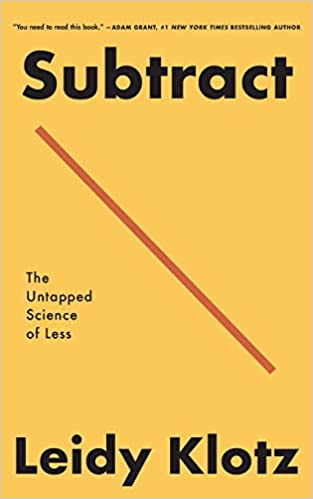
Subtract: The Untapped Science of Less - by Leidy Klotz
Date read: 2023-03-17How strongly I recommend it: 5/10
(See my list of 150+ books, for more.)
Go to the Amazon page for details and reviews.
In a world where adding is seen as the norm, the author suggests subtracting more to be more productive and to improve our lives. Although I agree with the concept, I felt that the book veered away from it's intent and was too drawn out, spending more than half of the book trying to convince me the importance of subtracting through ill-conceived examples.
My Notes
Lao Tzu advised: “To attain knowledge, add things every day. To attain wisdom, subtract things every day.”
We add more than we subtract, that doing so causes us to miss out on good options, sometimes because we don’t even think of taking away.
Having less time to think leads to less subtracting.
Keichline’s hollow block required half the material compared to what was then the typical building block (concrete blocks that are hollow in the middle creating less mass).
To find the options we are missing, we need to go from thinking add or subtract to thinking add and subtract.
Focus on the human element: What makes Kondo’s message unique and powerful is her emphasis on “sparking joy.” Whereas default home organization advice is to get rid of things you don’t want, or that don’t fit, Kondo flipped that logic around—and focused it on us humans. she said we should keep what sparks joy and get rid of everything else.
Loss aversion is powerful, widespread, and well publicized. But loss aversion should not excuse our subtraction neglect. The subtraction we are after is an improvement—and improvement is not a loss, even when it comes via less.
Daniel Kahneman put it this way: “Lewin’s insight was that if you want to achieve change in behavior, there is one good way to do it and one bad way. The good way is by diminishing restraining forces, not by increasing the driving forces.” Lewin’s “bad way” was to add—whether incentives for good behavior or punishments for bad behavior—because this increases tension in the system.
Subtracting detail—to get to the essence of the system—has saved thousands of lives. Example, improving how catheters at hospitals are administered.
When dealing with complex systems, subtract steps to only include those that are absolutely necessary.
The less-list:
- Subtract before improving (e.g., triage)
- Make subtracting first (e.g., Jenga)
- Persist to noticeable less (e.g., Springsteen’s Darkness)
- Reuse your subtractions (e.g., doughnut holes)
Since I’ve been writing fewer idea notes, I’ve saved frustrating time trying to make sense of old ideas my unconscious brain would have otherwise weeded. This has left more time for the good ideas. And I don’t think I’ve forgotten anything important—though I suppose I wouldn’t know.
Note: consider going back through my previous book notes and pruning them to remove non-essential passages.
Analogies subtract detail to declutter the knowledge before it goes into our mental models.